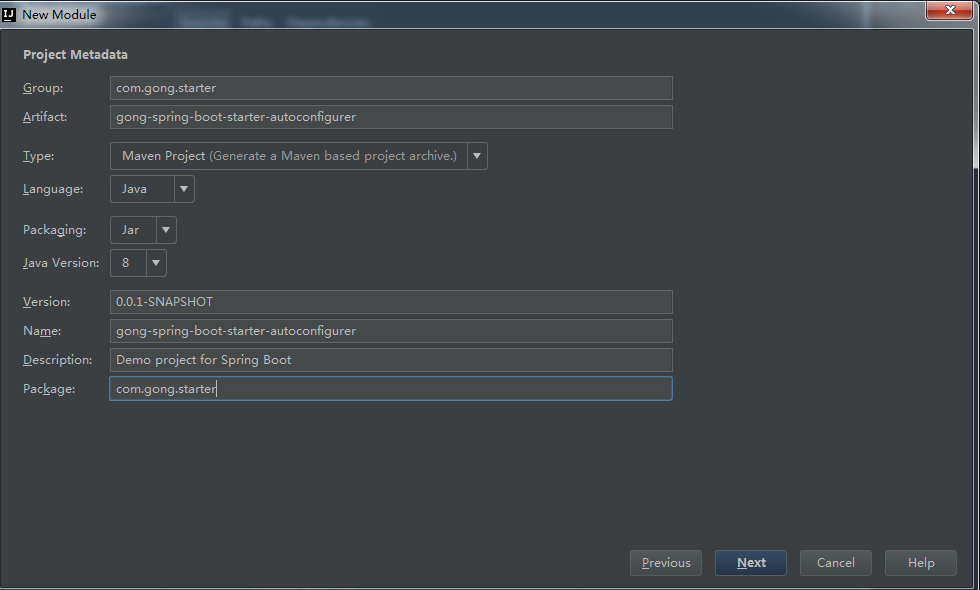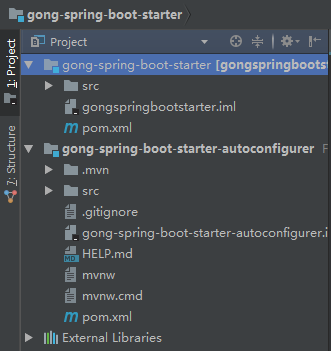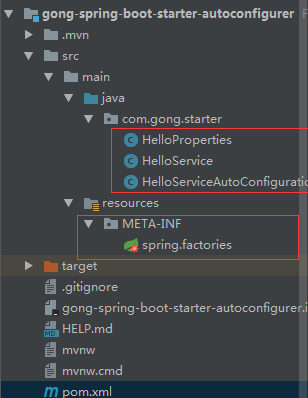1、创建一个Empty Project
2、在该工程中点击+,选择new module,新建一个maven工程



点击确定。
3、在该工程中点击+,选择new module,新建一个Spring Initializr工程

后面直接默认next,然后点击finishi。
两个都创建完毕之后点击apply,点击OK。得到如下结构:

4、在gong-spring-boot-starter中引入gong-spring-boot-starter-autoconfigurer,即在gong-spring-boot-starter的pom.xml中
<?xml version="1.0" encoding="UTF-8"?> <project xmlns="http://maven.apache.org/POM/4.0.0" xmlns:xsi="http://www.w3.org/2001/XMLSchema-instance" xsi:schemaLocation="http://maven.apache.org/POM/4.0.0 http://maven.apache.org/xsd/maven-4.0.0.xsd"> <modelVersion>4.0.0</modelVersion> <groupId>com.gong.starter</groupId> <artifactId>gong.spring-boot-starter</artifactId> <version>1.0-SNAPSHOT</version> <dependencies> <!--引入自动配置模块--> <dependency> <groupId>com.gong.starter</groupId> <artifactId>gong-spring-boot-starter-autoconfigurer</artifactId> <version>0.0.1-SNAPSHOT</version> </dependency> </dependencies> </project>
我们看下gong-spring-boot-starter-autoconfigurer中的pom.xml
<?xml version="1.0" encoding="UTF-8"?> <project xmlns="http://maven.apache.org/POM/4.0.0" xmlns:xsi="http://www.w3.org/2001/XMLSchema-instance" xsi:schemaLocation="http://maven.apache.org/POM/4.0.0 https://maven.apache.org/xsd/maven-4.0.0.xsd"> <modelVersion>4.0.0</modelVersion> <parent> <groupId>org.springframework.boot</groupId> <artifactId>spring-boot-starter-parent</artifactId> <version>2.2.4.RELEASE</version> <relativePath/> <!-- lookup parent from repository --> </parent> <groupId>com.gong.starter</groupId> <artifactId>gong-spring-boot-starter-autoconfigurer</artifactId> <version>0.0.1-SNAPSHOT</version> <name>gong-spring-boot-starter-autoconfigurer</name> <description>Demo project for Spring Boot</description> <properties> <java.version>1.8</java.version> </properties> <dependencies> <!--引入spring-boot-starter:所有starter基本配置--> <dependency> <groupId>org.springframework.boot</groupId> <artifactId>spring-boot-starter</artifactId> </dependency> </dependencies> </project>
删除掉创建项目时自动配置的其它东西,只需要一个标红的依赖即可。
5、在gong-spring-boot-starter-autoconfigurer就可以编写场景启动的相关逻辑啦。
(1)新建如下目录结构及文件

springboot启动入口可以删去,resources下文件删去,test文件夹删去。在com.gong.starter下新建以上三个java文件,在resources下新建META-INF文件夹,再新建spring.factories文件。
HelloService.java
package com.gong.starter; public class HelloService { HelloProperties helloProperties; public HelloProperties getHelloProperties() { return helloProperties; } public void setHelloProperties(HelloProperties helloProperties) { this.helloProperties = helloProperties; } public String sayHelloGong(String name){ return helloProperties.getPrefix()+"-" +name + helloProperties.getSuffix(); } }
sayHelloGong方法可以获取HelloProperties中的属性,包括前缀和后缀,然后返回:前缀-name后缀。
HelloProperties.java
package com.gong.starter; import org.springframework.boot.context.properties.ConfigurationProperties; //绑定所有以gong.hello开头的配置 @ConfigurationProperties(prefix = "gong.hello") public class HelloProperties { private String prefix; private String suffix; public String getPrefix() { return prefix; } public void setPrefix(String prefix) { this.prefix = prefix; } public String getSuffix() { return suffix; } public void setSuffix(String suffix) { this.suffix = suffix; } }
绑定配置以及定义属性。
HelloServiceAutoConfiguration.java
package com.gong.starter; import org.springframework.beans.factory.annotation.Autowired; import org.springframework.boot.autoconfigure.condition.ConditionalOnWebApplication; import org.springframework.boot.context.properties.EnableConfigurationProperties; import org.springframework.context.annotation.Bean; import org.springframework.context.annotation.Configuration; @Configuration //是一个配置类 @ConditionalOnWebApplication //web应用才生效 @EnableConfigurationProperties(HelloProperties.class) //让属性文件生效 public class HelloServiceAutoConfiguration { @Autowired HelloProperties helloProperties; @Bean public HelloService helloService(){ HelloService service = new HelloService(); service.setHelloProperties(helloProperties); return service; } }
自动配置类。要加入三个注解,并对方法使用@Bean标注。
最后,就是在spring.factories中进行配置自动注册:
org.springframework.boot.autoconfigure.EnableAutoConfiguration= com.gong.starter.HelloServiceAutoConfiguration
这样,我们自己定义的场景启动器就完成了。
接下来新建一个springboot项目进行测试,首先在pom.xml中导入自己定义的场景启动器:
<!--引入自定义的starter--> <dependency> <groupId>com.gong.starter</groupId> <artifactId>gong.spring-boot-starter</artifactId> <version>1.0-SNAPSHOT</version> </dependency>
然后编写application.properties定义场景启动器的属性:
gong.hello.prefix=GONG
gong.hello.suffix=HELLO WORLD
接着编写一个测试类:
package com.gong.springbootjpa.controller; import com.gong.starter.HelloService; import org.springframework.beans.factory.annotation.Autowired; import org.springframework.web.bind.annotation.GetMapping; import org.springframework.web.bind.annotation.RestController; @RestController public class HelloController { @Autowired HelloService helloService; @GetMapping("/hello") public String hello(){ return helloService.sayHelloGong("haha"); } }
启动服务器:

完美。